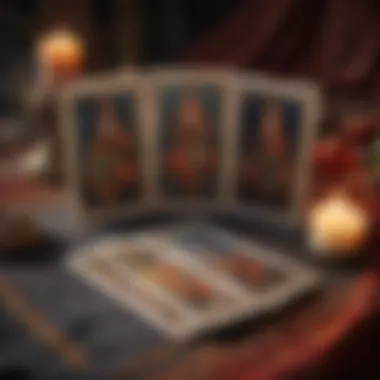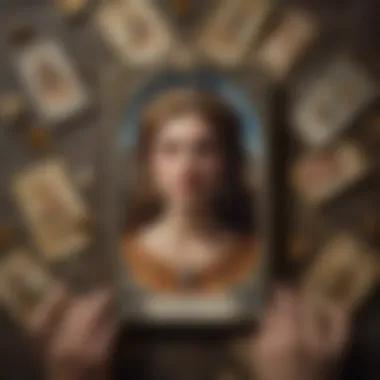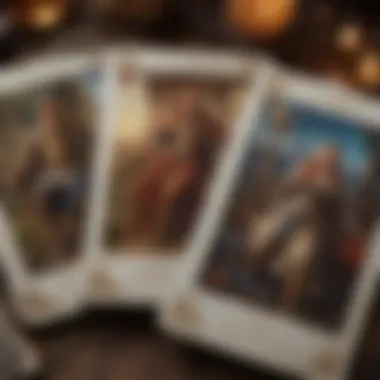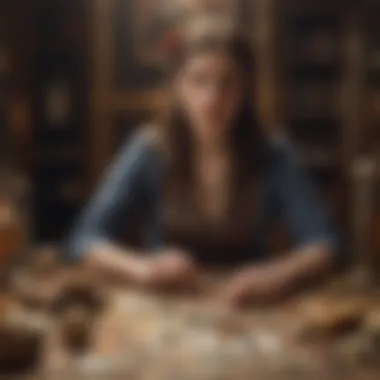Understanding the Three Card Tarot Spread: A Deep Dive


Intro
The three card tarot spread is a foundational technique in tarot reading. It is favored for its simplicity and depth, making it accessible for both novice and experienced practitioners. This spread typically involves three cards, each representing a significant aspect of the question at hand. The structure allows for a variety of interpretations based on the cards drawn and their positions, creating a rich tapestry of guidance and insight.
In this article, we will delve into the structure and significance of the three card tarot spread, discuss the role of each card in the context of the spread, and explore how practitioners can effectively interpret the combinations that arise. By understanding the nuances of this spread, readers can enhance their skills in tarot readings, leading to a more profound journey of self-discovery and reflection.
Furthermore, we will discuss the historical context of tarot as a divination tool, tracing its evolution and impact on modern practices. Readers will gain insights into how the three card spread can illuminate personal and relational dynamics, providing valuable perspectives on life's challenges and decisions.
This guide aims to furnish a comprehensive understanding of the three card tarot spread, making it a valuable resource for anyone looking to deepen their knowledge in this field.
Prelims to Tarot
Tarot serves as both a reflective tool and a means of divination. Its relevance stretches across cultures and eras, symbolizing a deep human desire to seek clarity about the personal journey. Understanding Tarot lays the foundation for interpreting its cards effectively, particularly the three card spread, which is a favored approach due to its simplicity and depth. By grasping the principles of Tarot, practitioners can harness the insights offered by the cards, leading to informed decisions and enhanced self-awareness.
The structured nature of Tarot provides a framework through which individuals can engage with their thoughts and emotions. A Tarot deck is not just a collection of images but a dynamic narrative waiting to unfold. Each card tells a story, offering guidance and reflection tailored to the reader's context.
In this section, we will explore the historical significance, evolution, and key components of the Tarot deck, culminating in a better appreciation of how these elements contribute to the understanding of the three card spread. This knowledge positions users to make the most out of their readings, enriching their experience and illuminating their paths.
Understanding the Three Card Spread
The three card spread is a foundational technique in tarot reading, valued for its elegance and clarity. This spread is often used by both novices and experienced practitioners to explore different aspects of a situation or issue. Each card serves a distinct purpose, providing insights that can help one navigate personal and relational challenges. By understanding this spread, practitioners can foster more meaningful interpretations that lead to deeper self-discovery and growth.
Structure of the Three Card Spread
The three card spread is typically laid out in a linear form where three cards are drawn and placed side by side. Each position of the cards has a specific meaning:
- First Card: Represents the past influences on the current situation.
- Second Card: Highlights the present circumstances or the heart of the matter.
- Third Card: Suggests future possibilities or outcomes based on current energies.
This structure provides a flow of narrative from past, through present, and into the future, which is crucial for making connections between the cards. When selecting cards, one may choose to shuffle the deck while focusing on a question or intention. The resulting cards then tell a story, allowing the reader to weave together the meanings derived from each position.
Significance of Three Cards
The number three holds significant symbolism in various cultures and traditions, often representing concepts of balance, harmony, and unity. In the context of tarot, the three cards collectively illustrate a compact yet powerful narrative. This triad allows for:
- Broader Perspectives: Three distinct viewpoints lead to a more rounded understanding of the situation.
- Dynamic Interaction: Each card interacts with others, providing layers of meaning that single-card draws may miss.
- Guidance: The cards can suggest varied directions based on the fluid interplay of past, present, and future.
By employing a three card spread, readers can glean multifaceted insights, enhancing their interpretations. This spread's significance lies not only in the individual meanings of the cards but also in how they correlate and inform one another.
Common Interpretations
Interpreting the three card spread involves understanding both individual cards and their relational dynamics. Here are some common interpretations:
- Positive Outcomes: When cards suggest favorable conditions, the reader may advise embracing opportunities or taking affirmative actions like pursuing personal goals.
- Challenging Situations: If the spread reveals challenges, the interpretation might focus on resilience, offering guidance on overcoming obstacles through reflection.
- Decision-Making Contexts: The spread can clarify which course of action aligns best with one’s values and expectations. Each card's position sheds light on which decisions resonate with the individual's path.
Readers often draw on their intuition, alongside traditional meanings, to decipher the nuances of each card's message. Ultimately, the three card spread acts as a profound tool for personal insight, capable of guiding one through the complexities of life.
Breaking Down Each Card
Understanding each card in the three card tarot spread is essential. Each card bears significance individually and collectively. By examining the individual meanings, practitioners gain clarity on the broader narrative being told within the spread. This section will explore the facets of each card, highlighting their roles and contributions to an overall reading. Recognizing how each card interacts with the others enhances interpretative depth.
The Meaning of the First Card
Core Interpretations
The first card in the spread often represents the querent's current situation or the core issue at hand. It sheds light on the primary theme guiding the reading. Core interpretations focus on the intrinsic meaning behind the card. Its importance lies in revealing immediate challenges or opportunities faced by the seeker. Each tarot card is layered with symbolic meaning, and understanding this rugged character offers foundational insights.


Furthermore, the first card sets the tone for the inquiry, making its interpretation pivotal. The unique feature of core interpretations is their straightforwardness, allowing practitioners to engage deeply without losing clarity. Readers can use established meanings to help with understanding.
Contextual Considerations
Contextual considerations emphasize the relevance of the first card concerning the individual’s life circumstances. Instead of solely leaning on traditional definitions, this approach encourages the reader to relate the card to the querent's personal experiences. The key characteristic of this method is its adaptability. Noticing nuances based on life context allows for a richer reading.
This unique aspect provides benefits such as increased relatability and personal engagement. However, there exists a disadvantage in potentially straying too far from established meanings and losing a thread of clarity.
The Meaning of the Second Card
Core Interpretations
The second card reflects influential factors that act upon the querent. It may represent a challenge or supportive energy. Core interpretations focus on identifying what this card reveals about external influences affecting the reading. These influences can range from internal emotions to social interactions.
The significance of the second card lies in how it interacts with the first card, either complicating or enriching its meaning. Core interpretations here provide a vital link between the internal and external worlds. The unique advantage lies in recognizing how external dynamics can subtly shift the querent’s approach to their primary issue.
Contextual Considerations
Contextual considerations for the second card focus on personal dynamics and relationships impacting the seeker. This perspective emphasizes relationships, social interactions, or environments influencing the situation. Understanding this context contributes meaningfully to the entire spread. Ignoring its relational aspects can lead to a loss of essential insights. The strength of this approach lies in its relational depth. This created a rich tapestry from which insights emerge.
However, much like the earlier section, an overemphasis on context may muddle inherent meanings from the cards. Balance is key.
The Meaning of the Third Card
Core Interpretations
The third card often symbolizes future outcomes or advice to the querent. Core interpretations focus on what lies ahead based on current actions and thoughts. This card holds prescriptive qualities, guiding the querent on necessary steps for progress.
The unique aspect of core interpretations here is their forward-looking nature. Readers can inspire action with insightful predictions. This establishes a tangible connection between current understanding and future direction. The core interpretation is beneficial as it constructs a bridge from present realities to future possibilities.
Contextual Considerations
Contextual considerations for the third card emphasize the personalized guidance it offers regarding the querent's path ahead. Understanding how this card relates to the first and second cards creates a narrative flow. The key characteristics include fitting advice into the unique story being told in that moment. This becomes an essential aspect of interpreting the tarot effectively.
The advantage here is the potential for tailored advice. However, readers must be cautious as too much focus might overlook broader themes present across the three cards.
In summary, breaking down each card unveils layers of meaning that contribute significantly to a reading. Individual interpretations combined with specific contexts yield a comprehensive understanding and guide readers on how to proceed in their life journeys.
Interpreting Combinations
Interpreting combinations of cards in a three-card tarot spread adds depth and context to your reading. A singular card may convey a specific meaning, but when combined with others, its significance can shift. The relationship between cards is a vital aspect of tarot reading, revealing nuances that may go unnoticed when interpreted in isolation. This understanding encourages a more holistic approach toward self-reflection and relational dynamics.
When looking at the combinations, you have to consider several elements. First, the positions of the cards in the spread matter. Each card's placement can signify different aspects of a situation—past influences, present conditions, or future possibilities. Second, the element of synergy becomes crucial. Some cards bolster each other's meaning while others might bring contrasting energies to the interpretation.
Realizing the benefits of interpreting combinations allows readers to discover insights that might not be evident through individual card readings. By analyzing how one card relates to another, you can uncover themes and issues that require attention. This complexity leads to richer narratives, enabling a more thorough understanding of the self and the circumstances at hand.
Common Card Pairings
Certain card pairings often occur in practice, revealing specific themes or messages. For example, if The Lovers appears alongside The Tower, it can symbolize a tumultuous relationship that requires transformation. Alternatively, pairing The Moon with The Star may indicate a journey through uncertainty toward future hope.
Here are some common pairings and their potential meanings:
- The Fool + The World: New beginnings leading to completed cycles.
- Death + Ten of Cups: Endings that pave the way for emotional fulfillment.
- Three of Swords + Ace of Cups: Heartbreak giving rise to new love opportunities.
Insights from Card Relationships
The relationship between cards provides essential insights that shouldn't be overlooked. Every card reacts to the ones nearby, creating dialogues that can enhance the message. For example, if a card associated with conflict, like Five of Wands, is next to a card traditionally linked with harmony, like Two of Cups, it may suggest a struggle within a relationship that still holds potential.


Many readers find it useful to explore contrasting energies as opportunities for growth. A negative card does not negate the presence of positive cards; instead, a balance is created that can inspire personal development or a shift in perspective.
"Understanding the nuances in card relationships allows for a more profound narrative of the reading, often guiding the seeker toward critical reflections in their life."
Contextual Interpretation Strategies
When interpreting combinations, consider using contextual interpretation strategies. This means taking into account the phase of life the seeker is in, the specific question posed, and the emotional states involved.
For example, in a career-related spread, the presence of The Emperor along with The Hermit might suggest a tension between authority and solitude. Alternatively, if you see Two of Pentacles alongside Six of Swords, it may indicate a need for balance while navigating a transition.
Utilize these strategies for richer interpretations:
- Ask Specific Questions: Frame inquiries to guide interpretation.
- Track Theme versus Context: Look for overarching themes while remaining adaptable to the present situation.
- Review Previous Patterns: Consider the asker's past experiences relevant to the cards involved.
By employing these strategies, readers can deepen their understanding of how combinations produce valuable insights and foster growth.
Practical Applications of the Three Card Spread
The three card tarot spread serves as a versatile tool in the realm of divination. Its applications span various personal and relational contexts, enabling individuals to gain valuable insights and guidance. Each reading can lead to different revelations based on the question posed and the cards drawn. This section delves into specific areas where the three card spread can be particularly beneficial, including self-reflection, relationship analysis, and decision-making guidance.
Self-Reflection and Growth
In the ever-evolving journey of self-discovery, the three card spread plays a crucial role. It facilitates a structured yet flexible approach to introspection. By asking a deep, personal question, users can draw three cards to represent their past, present, and future states. This layout prompts an individual to critically evaluate their current life situation and the influences shaping it.
Using the insights from the cards can promote significant personal growth. For instance, if the first card signifies a challenge faced in the past, it encourages reflection on that experience. The second card might represent current actions or attitudes, while the third card can suggest future opportunities or results if the individual continues on the same path. This structured approach helps users identify patterns, understand triggers, and ultimately foster a proactive mindset toward self-improvement.
Relationship Insights
The three card spread is also a powerful method for gaining clarity in interpersonal relationships. It aids in unpacking complex dynamics by revealing underlying factors and influences. To analyze a relationship, one might focus the reading on a specific partnership, whether romantic, familial, or professional.
For instance, the first card can represent the individual’s perception of the relationship, the second may illustrate the other person's perspective, and the third can illuminate the potential for future growth or challenges. This format encourages open dialogue and understanding, allowing for introspection and communication.
By examining relationship insights through the lens of tarot cards, individuals can identify areas that need attention or change. This almost mirrors a mirror, reflecting the psyche of both parties involved, which can lead to more harmonious connections.
Decision Making Guidance
In situations requiring critical choices, the three card spread can serve as a form of guidance. This aspect is particularly relevant in today's fast-paced environment, where decisions often feel overwhelming. By framing the spread in response to a specific decision, the user can gain clarity on differing options.
Commonly, the first card may represent the advantages of one option, the second card might reveal the drawbacks, and the third could suggest what the future might hold depending on the chosen path. This systematic approach enables individuals to consider the potential outcomes of their decisions more carefully.
"The art of tarot thrives not just in fortune-telling, but in self-discovery and empowerment."
Through its structured format and depth, the three card spread can illuminate paths that might otherwise remain hidden.
Tips for Conducting a Three Card Reading
Conducting a three-card tarot reading involves more than merely drawing cards. It requires atttunement to your intention and the context of the inquiry. This section will explore critical tips to enhance the experience and insights gained from your reading. Proper preparation and execution can reveal deeper meanings and provide clarity on the matters at hand.
Setting Your Intention
Before beginning a reading, it is essential to set a clear intention. This process acts as a guide, a purpose for the reading. An intention can range from seeking guidance on a decision to understanding current emotional states or exploring future possibilities. Consider the following elements:
- Define your question: Be specific. Instead of asking broad questions like, "What is my future?" focus on detailed inquiries such as, "What should I prioritize in my career right now?"
- Stay open-minded: While having a clear question is important, be even more willing to accept the insight that comes. The cards may not always confirm your expectations.
- Create a space: Find a quiet, calm environment where you feel comfortable. This is important for focusing on your intention without interruptions.
Setting your intention prepares your mind for clarity and opens the channel for insight, enhancing the reading's value.
Shuffling Techniques


Shuffling may seem a basic action, but it holds significance in a tarot reading. Proper shuffling techniques can influence the reading's quality.
- Focus on your question while shuffling: Keep your intention in mind. This helps to imbue the cards with energy related to your query.
- Mix thoroughly: Different methods such as overhand shuffling, riffle shuffling, or simply mixing cards face down can work. Choose what feels comfortable.
- Allow for intuition: Some practitioners feel guided to stop shuffling at a certain point, or they may draw cards without intentional shuffling. Trust that instinct.
Follow-Up Actions After a Reading
The reading does not end once the cards are laid out and interpreted. Engaging with the insights offered by the cards is crucial for making the most of your experience.
- Reflect: Take time to contemplate the meanings of the cards and how they relate to your life. Journaling thoughts can crystallize understanding.
- Apply the insights: Consider how the advice and guidance can be integrated into your life. Action leads to transformation.
- Connect with the cards: Keep the cards nearby for several days, allowing their messages to resonate further. Revisit your notes and see how they unfold over time.
In summary, these tips for conducting a three-card reading focus on the importance of clear intentions, effective shuffling methods, and meaningful follow-up actions. They deepen one’s understanding and engagement with the tarot, thereby enriching the reading experience.
Common Misconceptions About Tarot
The topic of common misconceptions about tarot is crucial. Understanding these misconceptions can lead to a clearer perception of tarot as a divination tool. Many people approach tarot with a sense of skepticism or fear, often due to misunderstandings. By addressing the myths surrounding tarot, the article can foster a more informed and open-minded discussion about its significance.
Taboos and Stigmas
Tarot is often wrapped in layers of taboos and stigmas. Many view it as a tool solely for fortune-telling, associating it with superstition. This reduces its complexity. Tarot's true nature lies in its potential for self-discovery and personal insight. These taboos often deter individuals from exploring tarot's deeper meanings.
Context matters significantly. In some cultures, tarot is linked with negative connotations due to its association with the occult. These beliefs can diminish its value as a reflective practice. Additionally, people may feel embarrassed to express interest in tarot, fearing judgment from peers.
Dispelling these myths is crucial. Understanding that tarot can be a psychological tool rather than just a mystical one can change perceptions. By emphasizing its role in personal growth, we shift the focus from fear to understanding.
The Role of Interpretation in Tarot
Interpretation is fundamental in tarot reading. Each card carries a wealth of meanings, but these interpretations can fluctuate based on context. A common misconception is that there is a single, correct meaning for each card. This idea undermines the nuance involved in readings.
Readers must consider factors like the question posed, the position of the card in the spread, and personal intuition. This approach allows for a deeper connection with the cards. The interpretive process can unveil not just future possibilities but also reflect on current situations.
This emphasis on interpretation showcases the tarot as a conversation with oneself rather than a rigid structure. Such an understanding invites more engagement and encourages a flexible perspective.
Fact vs. Fiction in Divination
Divination practices, including tarot, often mix fact with fiction. The dramatic portrayals of tarot in media contribute to widespread misconceptions. Many believe tarot can predict the future with absolute certainty. This belief aligns more closely with fiction than reality.
In fact, tarot serves as a tool for reflection and insight rather than a crystal ball. It reveals possibilities based on current situations. Misunderstandings may lead individuals to depend entirely on tarot for life decisions. Thus, it's vital to highlight that tarot should be viewed as a guide, not a definitive answer.
The ongoing dialogue on these misconceptions can help in dispelling myths. It promotes awareness about the real applications of tarot, emphasizing its value in personal development.
The Future of Tarot and Divination
The future of tarot and divination represents a vibrant landscape of evolving practices and ideas. As more individuals seek deeper connections to their intuition and themselves, tarot is becoming a key instrument for self-exploration. The adaptability of the three card spread highlights its usefulness in varied contexts, whether for personal growth or interpersonal insights. Understanding these dynamics can significantly enhance the user's experience, making tarot reading not only relevant but essential in today's fast-paced environment.
Emerging Trends in Tarot Practices
Now, tarot practices are expanding rapidly. There is a notable shift towards personalized readings, where readers are incorporating specific themes that resonate with individual querents. Some practitioners use alternative systems of astrology, numerology, or even psychology to tailor their readings. This emphasis on personal relevance reflects the changing needs of those seeking guidance. Additionally, community-based learning, such as group readings and workshops, is on the rise, fostering connections and shared insights among participants.
Other practices include the integration of journaling with readings. Many tarot readers now suggest that clients document their thoughts and feelings after each session, creating a tangible record of their journey. This can deepen insights and reinforce lessons learned from the cards.
Integration of Technology in Tarot Readings
Technology is reshaping tarot readings in significant ways. Online platforms and apps are emerging, allowing practitioners to reach a broader audience. The accessibility of digital readings breaks geographical barriers, making tarot more inclusive.
Many users enjoy virtual consultations through video chats. This format creates a new intimacy, as readers and querents can interact in real-time, even from distant locations. Furthermore, there are apps that help beginners learn card meanings and spreads, democratizing tarot knowledge. Interestingly, artificial intelligence is also being explored for generating personalized tarot readings, sparking debate on the authenticity and depth of machine-generated guidance.
The Continued Relevance of Tarot
Despite evolving forms, tarot remains relevant for several reasons. It serves as a powerful reflection tool, helping individuals navigate life's complexities. In uncertain times, people often seek clarity and insight, making the three card spread an ideal choice due to its simplicity and focus.
Moreover, tarot’s adaptability means it can address modern issues. Whether discussing mental health, relationships, or career choices, tarot provides valuable perspectives. Social media has also played a role in keeping tarot alive. Influencers and practitioners share their insights online, contributing to a community that values spiritual exploration.
The future of tarot and divination certainly looks promising. By staying attuned to these trends and shifts, practitioners can continue to offer meaningful guidance, ensuring that tarot remains an integral part of many individuals' journeys.







